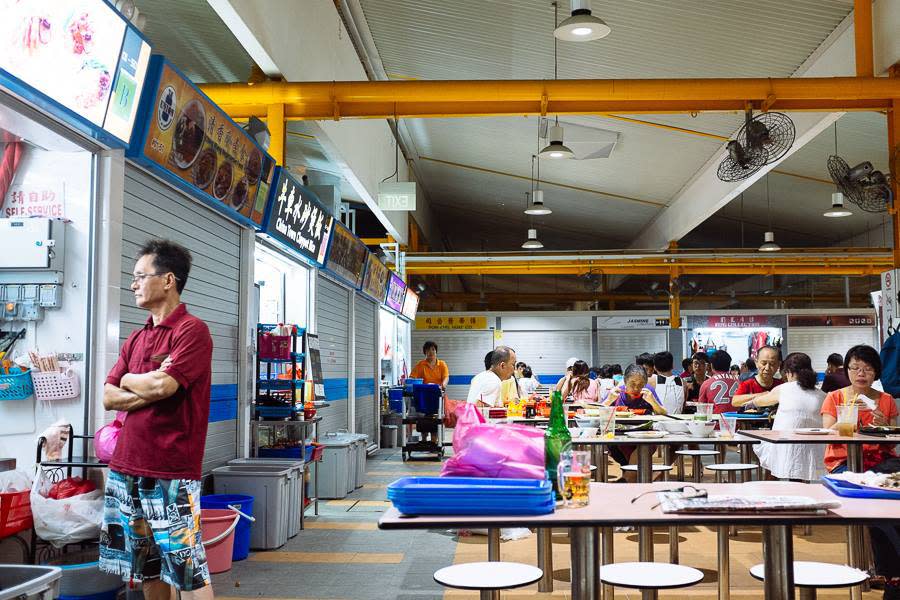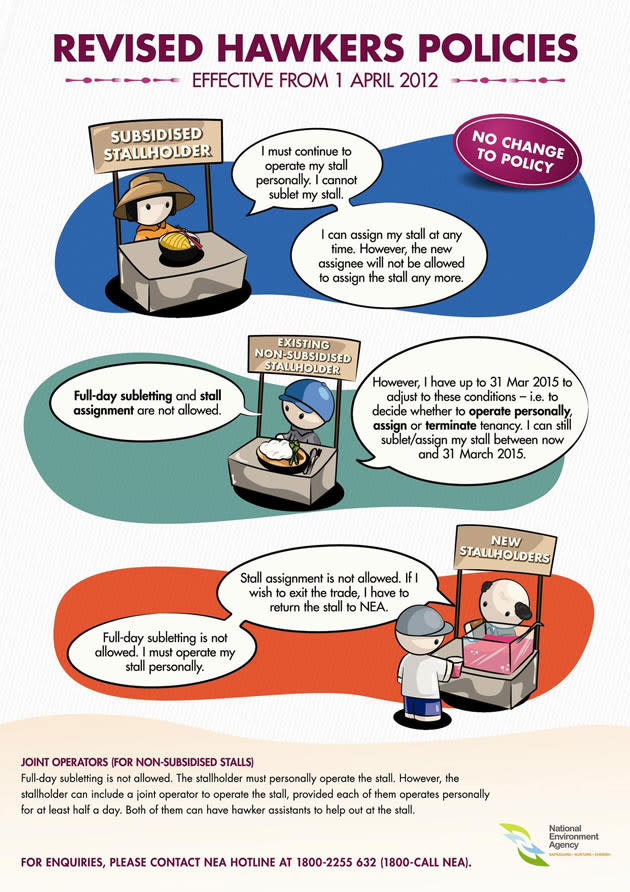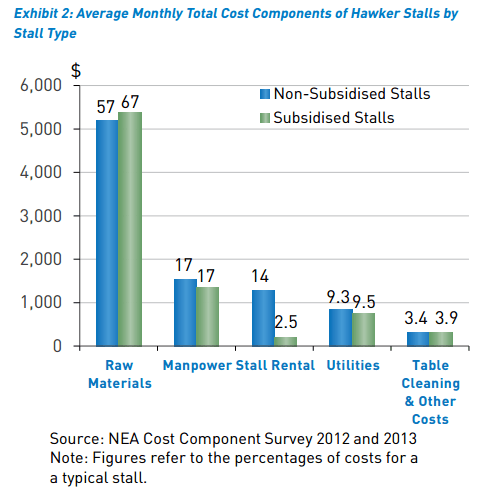11 Things to Know Before Opening a Singapore Hawker Stall

With more hawker centres opening, a new generation of Singapore hawkers will emerge to fill the demand with more opportunities arising. If you are one of these vendor hopefuls looking for a potential hawker stall, read this before you take the plunge into Singapore’s nitty-gritty F&B hawker industry.
1. Not all Hawker Centres In Singapore Are Government-Owned & Managed
107 markets/hawker centres in Singapore are managed by the National Environment Agency (NEA), who is responsible for tenancies, licensing and public health aspects of nearly 15,000 cooked food and market stalls. Out of these 107 centres, 82 are owned by the Housing Development Board (HDB).
Some hipster hawker centers are privately owned like Kopitiam’s Lau Pa Sat and the Limbang Wet Market in Choa Chu Kang.
The government has pledged to build 20 more hawker centres to be managed by social enterprises.
Fei Siong Food Management currently manages a hawker centre in Hougang.
NTUC Foodfare is managing the Bedok Interchange Hawker Centre and the upcoming Bukit Panjang Hawker Centre which will open in the last quarter of 2015.
2. New Hawker Stall Tenders are Announced Through Mainstream Media & NEA Website
To learn about new hawker centre tenders for social enterprise-run hawker centres, these announcements are usually made over local mainstream media like Straits Times, Lianhe Zao Bao, Berita Harian and Tamil Murasu.
For government-owned hawker stalls under NEA, a monthly tender exercise is offered to the general public in the middle of each month. Only Singaporeans/Permanent Residents not less than 21 years of age are allowed to tender.
Other sources to learn about new hawker stall announcements can also be found from NEA’s website.
3. Read the tender details carefully
You can get tender documents from the relevant management authority’s office (e.g. NEA, NTUC Foodfare) for a non-refundable fee of $10.
Together with the application, you need to enclose a one month deposit of the tendered rent as a Cashier’s Order to the designated management company, but it will not be cashed until successful tender. Failed tenderers will be returned their Cashier’s Order.
NEA will forfeit your tender deposit if you don’t commence operations within 3 months of signing the tenancy agreement, and may even terminate your tenancy and debar you from future tenders.
For NTUC Foodfare tenders, you’ll lose your tender deposit if you withdraw the tender after the closing date, but before the award of tender is announced.
So if you’re not serious about being a hawker, don’t anyhow play play and submit a tender.
4. Potential Hawker Stalls Are Chosen Not Just On Price
For some tenders, due to the demand for hawker stall spots as well as to ensure quality of stalls, there is of course, an evaluation process based other than purely price.
At NTUC Foodfare’s new Bukit Panjang Hawker Centre for example, the evaluation criteria will be based on a scorecard with 40% for tendered rent, and 60% for quality, variety, selling price, experience and concept.
Shortlisted cooked food stall tenderers will also be required to participate in a food tasting exercise by a panel including grassroots representatives from the neighborhood. Maybe Gordon Ramsay will fly down to taste as well, just kidding!
Usually a mix of famous stalls, long running brands as well as young hawkerpreneurs apply as well resulting in high competition and oversubscription; Foodfare will have to look thru all of the other concept criteria (Pricing, Food Variety, Concept, Experience) first before shortlisting a select group of hawkers, which will then go thru another round of selection via the food tasting exercise mentioned.
5. You Can “Sublet” Out Your Stall Under These Terms
Since 1 April 2012, you cannot sublet or assign your stall for a full day to anyone else.
This means you still have to personally operate your stall, but you can have a joint operator if each of you personally operates the stall for at least half a day.

Source: NEA
6. There’s a Quota on the Type of Stalls Within 1 Hawker Centre
As much as I love my chicken rice, we can’t possibly have 1 hawker centre with 20 chicken rice stalls, can we? Each hawker centre tender has a quota for different types of stalls e.g. Halal, non-Halal, Indian, drinks, cut fruits.
There are also a number of Open Categories that can allow other food stalls not listed within the designated quota.
7. Most hawkers pay less than $1,500 a month on rental
There’s a high chance your rental will not hit more than $1,500 a month, which is still significantly lower than food courts. Or any other F&B location in Singapore in fact. The appraisal of hawker stall rentals is based on a valuation by a professional valuer.

Leases are usually contracted on a 3 year period, with early termination resulting in foregoing of rent deposit and a stern look of disapproval from NEA. However you can terminate your stall without penalty if you successfully tender for another stall in the same or any other hawker centre.
If you were lucky enough to bid a low rental price for your stall, remember that this low price only lasts for the lease period. You’ll have to pay NEA the market rate thereafter.
You sometimes hear old hawkers brag about how their rental is in the hundreds only, but that is only for subsidized stallholders under a Government’s hardship scheme that was discontinued in 1989.
Subsidized Rent per month can range from $160 – $320 but is only applicable to Subsidized stallholders who are the original stallholders that were relocated from the streets in the early 1970s or allocated stalls under the Government’s hardship scheme.
Gone are the good old days, and along came inflation.
8. Price Caps To Attract Customers
NTUC Foodfare and Fei Siong Food Management will respectively manage the new Bukit Panjang and Hougang hawker centres based on a ‘not-for-profit’ model.
Under this model, operating surplus generated by a hawker centre must be shared among its stakeholders (e.g. stallholders, the management company and the NEA), be used to create “social benefits” and cannot go to the management company’s shareholders.
Prices will be kept low with Fei Siong requiring each stall at Ci Yuan Community Centre to sell at least 2 dishes under $2.80, and Foodfare issuing price caps of only 2 basic dishes per stall at Bukit Panjang Hawker Centre.
9. There are Still Ways For Hawkers To Profit Around Price Caps on Dishes
As newer hawker centres are starting to be managed on the above mentioned social enterprise model including the latest hawker centres, price caps on basic dishes are being introduced. Affordable food pricing has to be made for residents in the area as well.
The loophole here is that only the basic dishes have a price cap at each cooked food stall. So a plain plate of chicken rice will not be sold for more than e.g. $2.50 as stipulated.
However, if you combine the chicken rice into a set meal, or with added ingredients like braised egg or char siew to create a variation of the dish, the pricing is up to stallholders to set.
Stallholders might also sell an Xtra Large or Lemon Fried chicken rice for a higher price too. Creativity has always been key in F&B profiting anyway.
10. Raw Material Is The Biggest Cost
A survey by NEA found that raw material costs contributed the bulk of total costs. So ensure you find the right suppliers and do your sums carefully beforehand.

Other costs may include:
Service & Conservancy Charges
Dishwashing Fee (for some hawker centres with dishwashers)
Note that you have to pay 7% GST on tendered rent if your bid are successful.
11. Make use of grants and schemes to reduce costs
The full range of entrepreneurial grants available in Singapore are pretty diverse, and in order to really reduce operating costs while boasting productivity, utilizing these local grants is crucial. Several government agencies as well as private schemes can provide this extra help that hawkers need:
Employment and Employability Institute (e2i) provides business grants to help with productivity and organises job fairs for employment.
One popular grant is the Inclusive Growth Programme by e2i, which funds up to 50% of your productivity improvement projects and can be used for multiple projects, subject to a cap of $150,000 a project and $500,000 per company per year.
SME Centrealso provides free consultation to help stall owners review what grants are available for them, and also helps to fill up and submit applications.
Another popular grant available in Singapore now is the Productivity and Innovation Credit (PIC), which gives up to $10,000 cash back and a 60% rebate on approved items that increase productivity. F&B Hawker relevant items include Cashier Point-of-sales system and even things like noodle makers or self-service ordering kiosks.
NTUC Foodfare provides bulk purchase schemes for their hawker stall holders to reduce cost of goods by buying together with other stallholders.
Hawkers can still choose to purchase directly from their own suppliers.
Fei Siong Food Management’s Entrepreneurship Programme and central purchasing system also helps entrepreneurs manage their business model and costs.
It can be overwhelming especially if you’re a first time Foodpreneur. Engaging e2i or SME centre consultants will help you navigate and apply for these very useful grants to get you started.
Read more about 10 Things You need to know before Starting a Singapore Food Business
*Special thanks to NTUC Foodfare for sharing their insights in the creation of this article.
The post 11 Things to Know Before Opening a Singapore Hawker Stall appeared first on SETHLUI.com.



